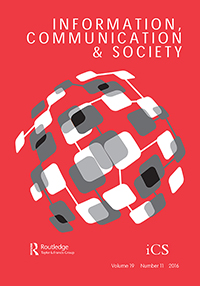 Dr. Miriam Sweeney (School of Library and Information Studies, University of Alabama) and I have a new paper published in Information, Communication & Society. In the article, titled “Creating Caring Institutions for Community Informatics,” we develop a feminist ethics of care framework for researchers and practitioners in the field of community informatics.
Dr. Miriam Sweeney (School of Library and Information Studies, University of Alabama) and I have a new paper published in Information, Communication & Society. In the article, titled “Creating Caring Institutions for Community Informatics,” we develop a feminist ethics of care framework for researchers and practitioners in the field of community informatics.
Here is the abstract:
This paper explores the potential affordances of applying a feminist ethics of care approach to community informatics practices in public internet access facilities. As feminist technology scholars have long observed, technology and technoculture are strongly encoded as masculine, privileging traits such as scientific knowledge, rationality, objectivity, and distance. These characteristics are expressed in traditional infomediary practices in a variety of ways, including notions of expertise, ways of conceptualizing technology, emphasis on skills attainment, and deficit-based models of user behavior. In contrast, ethics of care emphasizes the importance of relational and situated knowledge, pluralistic voices and experiences, and relationships bound by mutual interdependence. Traditionally, caring has been feminized and thus necessarily excluded from technoculture and relegated to invisible and unpaid labor. Caring and associated affective labor practices remain an under-examined subject in infomediary practices. Public libraries and community technology centers are logical places to explore for care work, given that they share many characteristics of the spaces where care work has historically been performed. We argue that an ethics of care framework has several possible affordances for infomediary practices in these institutions, including highlighting the gendered power dynamics that define and shape existing practices; distributing care work and making existing care work visible; and envisioning a more holistic and ethical approach to engaging diverse publics. We translate Tronto’s seven warning signs for ‘bad care’ in institutions into seven positive guidelines for providing ‘good care’ in public internet access facilities, then contextualize these for community informatics institutions and practices.
